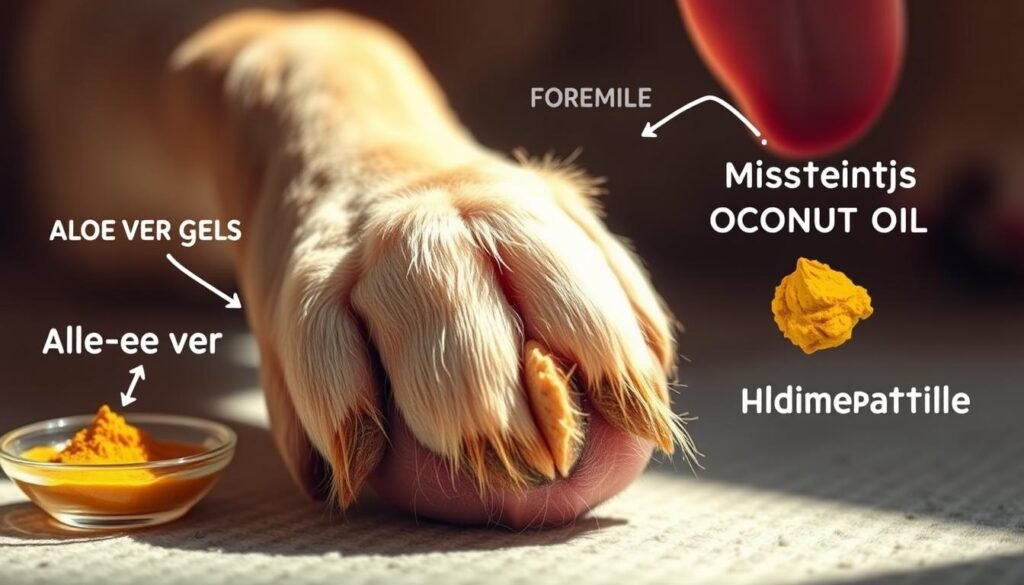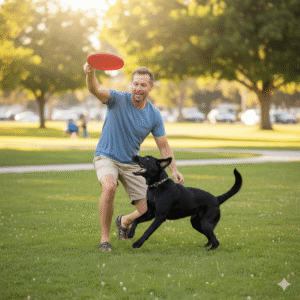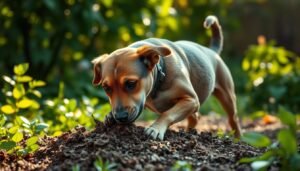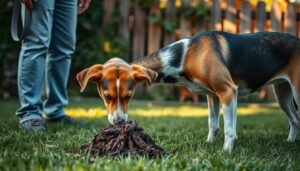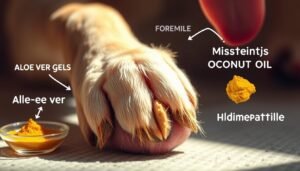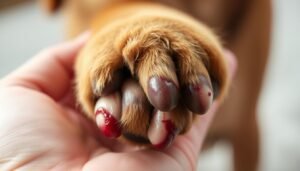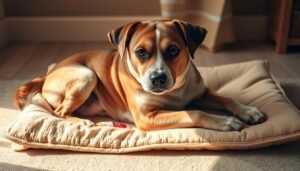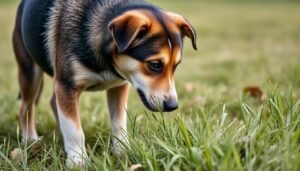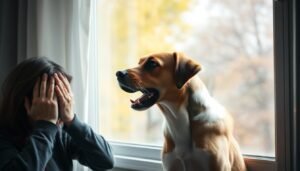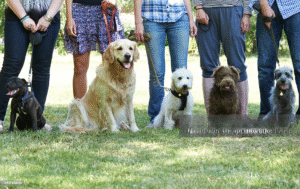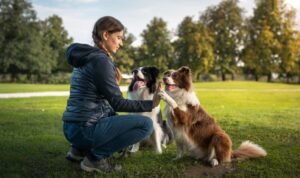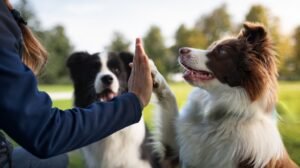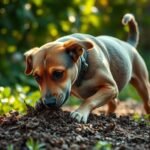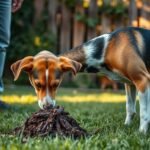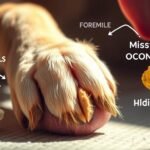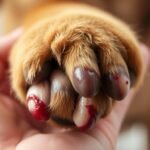As a dog owner, you’ve probably seen your furry friend licking their paws at some point. While it’s normal for dogs to lick their paws sometimes, too much licking can mean there’s a problem.
Excessive paw licking can make your dog uncomfortable and even lead to health issues. In this article, I’ll show you how to stop your dog from licking their paws. This way, your dog’s paws will stay healthy and comfy.
Key Takeaways
- Identify the underlying causes of dog paw licking
- Explore natural remedies to soothe and calm your dog’s paws
- Discover long-term strategies to manage paw licking behavior
- Learn simple home remedies to prevent paw licking
- Understand the importance of maintaining healthy paws for your dog
Understanding Why Dogs Lick Their Paws
It’s important to know why dogs lick their paws to solve the problem. Dogs lick their paws for many reasons, like health issues or behavior.
Common Causes of Paw Licking
Paw licking can be caused by several things. Allergies are a big reason, as dogs might react to things like pollen or dust mites. Skin infections and injuries to the paw can also make them lick.
- Allergies to pollen, dust mites, or certain materials
- Skin infections caused by bacteria or fungi
- Injuries such as cuts or burns on the paws
Health Issues Related to Paw Licking
Many health issues can make dogs lick their paws. Arthritis can cause pain, leading dogs to lick their paws to feel better. Anxiety and obsessive-compulsive disorder also make dogs lick their paws.
- Arthritis and joint pain
- Anxiety and stress
- Obsessive-compulsive disorder
Behavioral Factors in Paw Licking
Behavioral factors are also important in paw licking. Dogs might lick their paws because of boredom or stress. Finding and fixing these issues is crucial to stop the licking.
Understanding why dogs lick their paws is the first step to finding a home remedy. This will help you stop your dog from licking their paws.
Home Remedies to Help Stop Paw Licking
There are many home remedies to stop your dog from licking its paws. These can help keep your dog’s skin healthy. You can use them alone or together, based on what your dog needs.
Natural Antiseptics for Paw Health
Tea tree oil and aloe vera are great for soothing your dog’s paws. Tea tree oil fights off infections. Aloe vera calms irritated skin. Mix a few drops of tea tree oil with coconut oil and apply it to the paws. Use pure aloe vera directly on the paws, without additives.
Soothing Balms and Creams
Soothing balms and creams protect your dog’s paws. They reduce irritation and discomfort. Look for ones with beeswax, coconut oil, and shea butter. These ingredients keep moisture in and shield the paws from the outside world. Regular use can lessen your dog’s paw licking.
Herbal Treatments for Paw Care
Herbal treatments like chamomile and calendula have anti-inflammatory effects. They can lessen swelling and itching. Use chamomile tea as a paw rinse, and apply calendula cream directly. These herbs are gentle and can be used often to heal and comfort your dog’s paws.
For more info on why dogs lick their paws and how to stop it, check out this resource.
Creating a Paw-Friendly Environment
A paw-friendly home can help reduce your dog’s paw licking. Simple changes in your home can make your dog feel better. This leads to healthier paws for your furry friend.
Clean Living Spaces for Dogs
Keeping your home clean is key for your dog’s health. Vacuum and dust often to remove allergens. Focus on areas where your dog spends most of their time. Make sure these spots are free from dust, dirt, and allergens.
Safe Toys and Chew Options
Safe and durable toys can keep your dog from licking their paws. Choose toys that fit your dog’s size and chewing style. For more info on why dogs lick their paws and how to stop it, check out Best Friends.
| Toy Type | Benefits | Safety Tips |
|---|---|---|
| Rubber Toys | Durable and easy to clean | Supervise to avoid small parts |
| Fabric Toys | Soft and cuddly | Check for loose threads |
| Interactive Toys | Mentally stimulating | Ensure puzzle pieces are secure |
Organizing Dog Play Areas
Having a special play area for your dog can reduce stress and boredom. Ensure the play area is safe and free from hazards. Arrange toys and chews to encourage play and exploration.
By following these tips, you can make your dog’s environment more comfortable. This can help reduce paw licking.
Essential Oils that May Help
Certain essential oils can help manage dog paw licking naturally. These oils have therapeutic properties that soothe and calm the skin. This can reduce the urge to lick.
Safe Essential Oils for Dogs
Not all essential oils are safe for dogs. It’s important to find those that are gentle and beneficial. Lavender oil and chamomile oil are often recommended. They have calming effects that can help reduce stress and anxiety, common causes of paw licking.
Lavender oil is known for its soothing properties. It can calm irritated skin and reduce inflammation. Chamomile oil also has anti-inflammatory properties that help heal and soothe the skin.
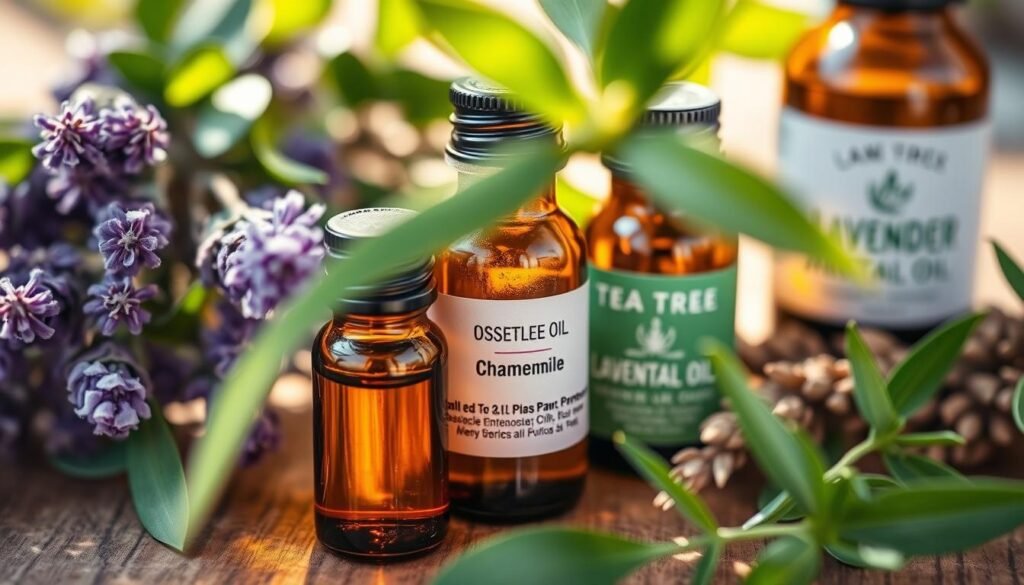
How to Use Essential Oils Properly
Using essential oils correctly is key to avoid adverse effects. Always dilute them with a carrier oil, like coconut or olive oil. A good dilution ratio is 1-2% essential oil to carrier oil.
- Mix a few drops of lavender or chamomile essential oil with a carrier oil.
- Gently apply the mixture to your dog’s paws, making sure to cover the affected areas.
- Observe your dog’s reaction and adjust the dilution ratio as needed.
Before adding new essential oils to your dog’s routine, talk to a vet. This is important to ensure safety and effectiveness. It helps prevent allergic reactions or interactions with other treatments.
Identifying Allergens That Cause Paw Licking
Allergens often make dogs lick their paws too much. Finding out what they are is crucial. It helps you understand why your dog might be licking its paws so much.
Common Allergens in the Home
Many household items can make dogs lick their paws. Dust mites, pollen, and some cleaning products are common culprits. Knowing which one might bother your dog is the first step.
How to Conduct an Allergen Trial
Doing an allergen trial means removing possible allergens one at a time. Watch how your dog reacts. This helps find out what’s causing the licking. For more tips on itchy pet paws, check out this resource.
To do an allergen trial, list all possible allergens in your dog’s space. Then, remove or lessen each one. Watch your dog closely for any changes. This careful method will show you what’s making your dog lick its paws.
Nutritional Adjustments for Healthy Skin
Changing your dog’s diet can greatly improve their skin health. A balanced diet that meets your dog’s needs is key for their health.
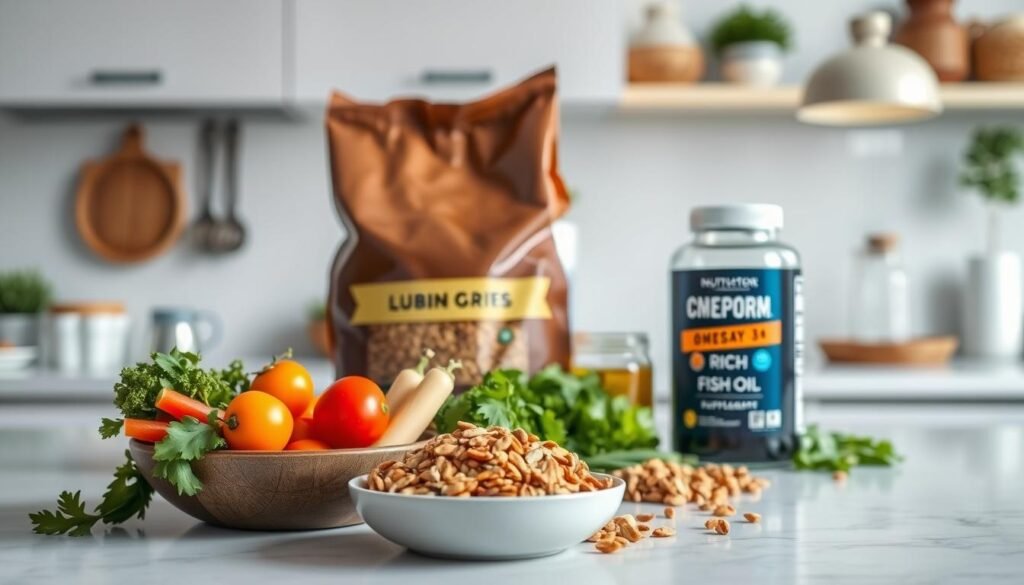
Supplements for Skin Health
Some supplements can boost your dog’s skin health. Omega-3 fatty acids help soothe irritated skin and reduce licking. Vitamin E also supports skin health by fighting off free radicals.
Adding these supplements to your dog’s diet can be done with various products. This includes fish oil capsules or vitamin E enriched dog foods. But, always talk to a vet before adding supplements to make sure they’re safe and needed.
Foods That Support Skin and Coat
Eating foods rich in antioxidants and fatty acids is good for your dog’s skin and coat. Salmon is full of omega-3 fatty acids, and sweet potatoes are packed with vitamins and minerals.
For more tips on changing your dog’s diet and stopping paw licking, check out Ultimate Pet Food’s resource on the topic.
Regular Grooming to Reduce Licking
Grooming your dog regularly can help reduce paw licking. It’s not just about looks; it’s also for their health and wellbeing.
Bathing and Cleaning Techniques
Proper bathing and cleaning are key to removing dirt and allergens. Use a mild dog shampoo that fits your dog’s skin type. Make sure to rinse well to avoid soap residue.
Cleaning your dog’s paws after walks can stop dog from licking paws. It removes irritants. Dry their paws, paying special attention to the areas between the toes, to prevent infections.
Importance of Nail Care
Nail care is vital for your dog’s comfort. Long or uneven nails can cause pain, leading to licking. Regular nail trimming can solve this problem.
Be careful when trimming your dog’s nails to avoid cutting the quick. It can be painful and lead to infection. If unsure, ask a professional groomer or vet for help.
Regular grooming improves your dog’s health and reduces paw licking. It allows you to catch any issues early and act quickly.
Engaging Your Dog in More Activities
To stop your dog from licking their paws, they need lots of physical and mental play. Dogs get bored or have too much energy and lick their paws to relax or play.
Physical Exercise to Distract from Licking
Regular exercise keeps your dog healthy and cuts down on paw licking. Activities like long walks, playtime in the yard, and fetch make them tired and keep their minds busy.
Here are some fun ways to get your dog moving:
- Daily walks of varying lengths and routes
- Playtime with interactive toys or fetch toys
- Swimming or water play for dogs that enjoy water
- Agility training for more energetic breeds
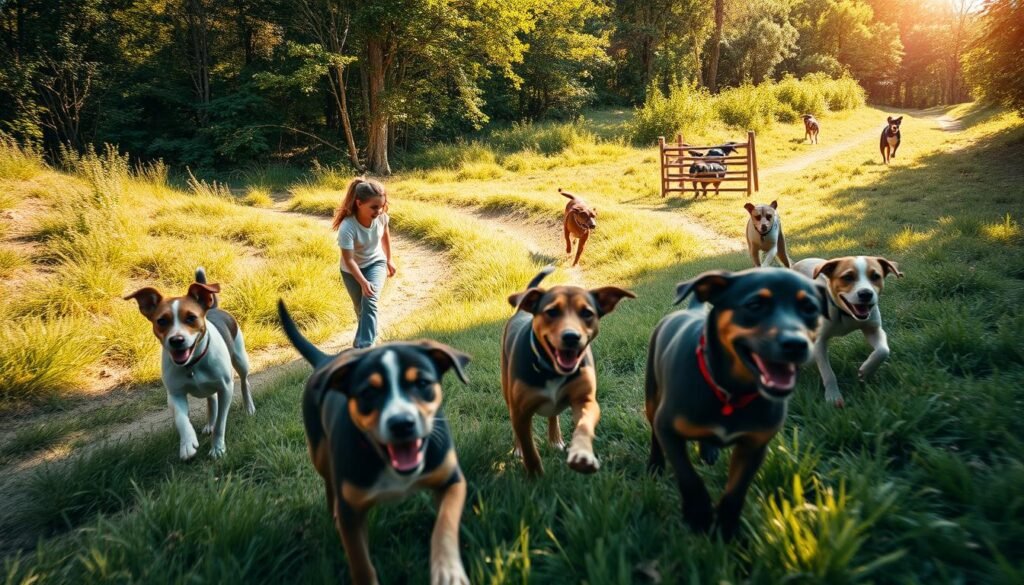
Mental Exercises and Training Games
Mental games are as important as physical ones. Playing training games and doing mental exercises keeps your dog’s mind sharp and stops them from licking their paws.
| Mental Exercise | Description | Benefits |
|---|---|---|
| Hide and Seek | Hide treats or toys around the house or yard, encouraging your dog to find them. | Improves problem-solving skills and reduces boredom. |
| Puzzle Toys | Fill puzzle toys with treats, challenging your dog to figure out how to get them out. | Enhances cognitive function and keeps your dog engaged. |
| Obedience Training | Practice basic obedience commands or learn new tricks. | Strengthens your bond with your dog and mentally stimulates them. |
By mixing physical and mental games into your dog’s day, you can lower paw licking from boredom or too much energy. This approach not only fixes the problem but also makes your dog happier and healthier.
When to Consult a Veterinarian
It’s important to know when your dog’s paw licking needs a vet. Home remedies can help a lot, but some cases need a vet’s help. This is because they might have a serious health problem.
Signs That Indicate a Serious Issue
Some signs show that your dog’s paw licking is serious. Look for persistent licking, redness and swelling on the paw, and discharge or a foul odor. If you see these, your dog needs a vet check.
For more info on why dogs lick their paws, check out BrightVet. They explain the reasons and treatments.
Importance of Professional Diagnosis
A vet can give a comprehensive diagnosis. They can find health issues like allergies, skin infections, arthritis, or anxiety. With their help, you can make a tailored treatment plan for your dog.
Seeing a vet helps solve the paw licking problem. It also helps find and treat any health issues that might affect your dog’s life.
Long-term Strategies to Manage Licking
Managing dog paw licking long-term means using many approaches. This includes training and keeping a clean home. These steps help your dog stop licking paws and stay healthy.
Training Techniques
Teaching your dog to listen and do other things can cut down licking. Positive reinforcement and redirecting their attention work well. These methods help distract your dog from licking.
Home Care Routines
Keeping a clean home and using natural remedies are key. Regular grooming and a clean space stop licking. It takes time and effort, but it’s worth it to keep your dog healthy.


